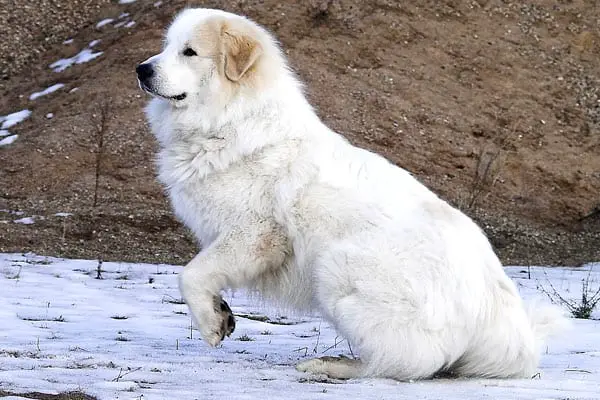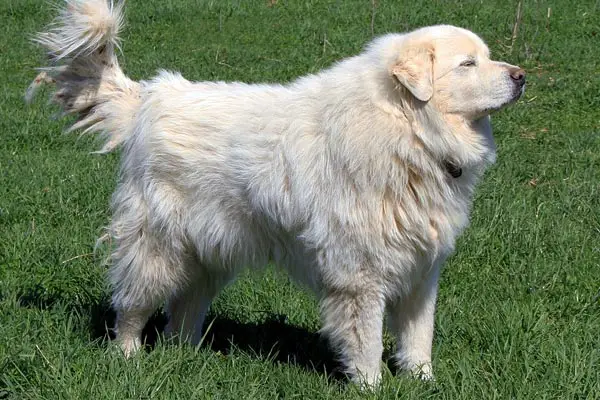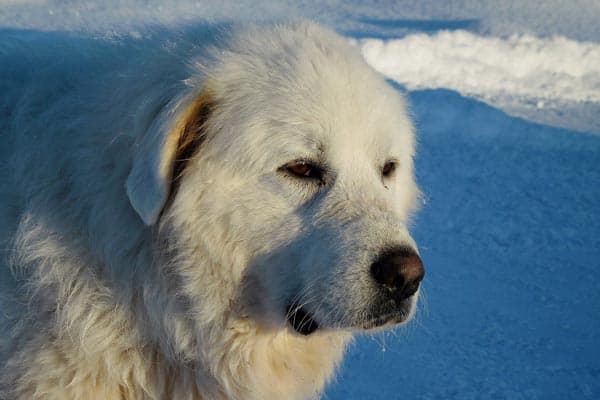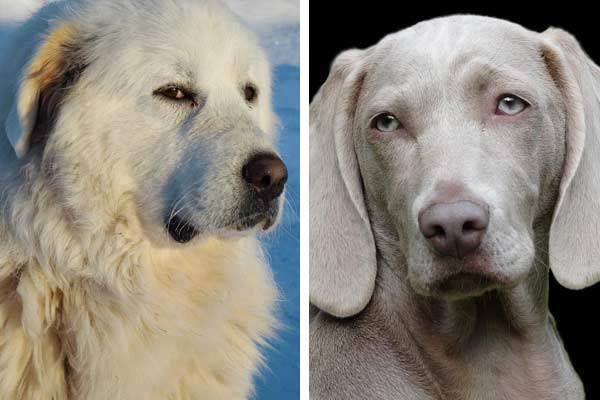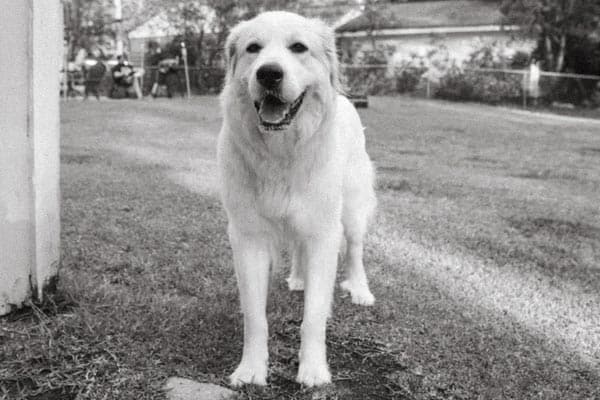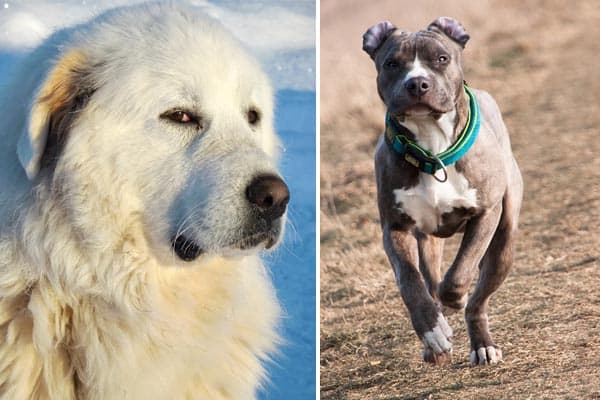Are Great Pyrenees Hypoallergenic? Why There is No Simple Answer
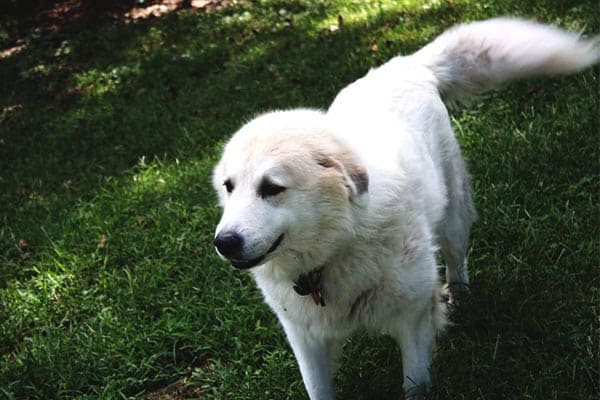
Are you in the market for a hypoallergenic dog? Maybe you love the Great Pyrenees breed and want to see if it will work for an allergy sufferer in your family.
First, you might want to look at what kind of fur is most likely to be hypoallergenic. Furthermore, what other factors besides hair type trigger allergies in sensitive people?
No, the Great Pyrenees is not hypoallergenic. The breed is among the worst choices for allergy sufferers.
Not only does the Great Pyrenees have a beautiful thick luxurious coat, but she also sheds and drools moderately. Dander and saliva arguably contribute more to trigger allergies than even long hair.
Moreover, with the Great Pyrenees’ impressive size, it is more difficult to contain loose fur and skin cells than it would be for a smaller dog.
Features of Dogs that Fanciers Classify as Hypoallergenic
What does it take for a dog to be hypoallergenic? Although there is no guarantee that any dog will be 100% hypoallergenic to all sensitive people, they often have one or more of the following characteristics.
- Single coat layer
- Continuously growing hair
- Minimal shedding
- Not an excessive groomer or licker
- Toy breed
- Silky long hair
- Hairless dog
- No drooling
The question of a hypoallergenic dog remains hotly debated
As several sources will tell you, the AKC does not recognize any dogs as 100% hypoallergenic. However, the registry concedes that allergy sufferers seem better able to tolerate certain breeds over others.
Despite many fanciers focusing on the amount of hair and the fur texture of dogs, those who suffer from pet allergies often react to the dander.
Scientific studies are limited but point out that the dogs most of us think of as hypoallergenic produce as much dander as furry breeds like the Great Pyrenees.
Another point is that dogs produce similar amounts of protein in their urine and saliva, more frequently a source of sensitivity to allergy sufferers than dander or hair, according to Mayo Clinic.
Oftentimes, the reason dander causes reactions is because of the proteins that stick to it from saliva. With low-shedding dogs, allergy-causing proteins tend to stay in the hair follicle, not as likely to trigger a reaction.
People who suffer from allergies can take steps to share a home with a dog with the following considerations.
- Smaller breeds have less hair and dander that is susceptible to becoming airborne or collecting in bedding and other surfaces; they also produce less saliva and urine because of their size
- Keep your dog well-groomed – Brushing and regular baths for your dog will keep loose hairs and dander to minimal levels
- Hairless dogs have less hair and possibly less dander; less hair for proteins to adhere to
- Make a few rooms off-limits to your dog – Give yourself areas where you can get away from known allergens
- Give yourself a break by having dedicated times for your pet to spend outdoors, weather permitting; exercising your dog outside or going for walks can also remove you from close confinement with dander particles and hair oils
- Wash bedding and shampoo carpets and upholstery frequently; consider hardwood floors or low-pile carpeting
- Vents and high-quality purifiers are a must for households where dogs and allergy sufferers want to coexist; run purifiers 4 or more hours per day
- Do your part with preventative measures that your medical professional recommends such as allergy shots, immunotherapy, and possible desensitization measures
- Some owners shave their dogs – Not ideal for a double-coated breed and of questionable value in lessening symptoms, according to Knisleys.com
Why are Great Pyrenees dogs not hypoallergenic?
Most dog lovers would take one look at the Great Pyrenees and readily deduce it is not a hypoallergenic breed.
Heavy Coat
One of the most endearing qualities of the Great Pyrenees that makes it so impressive also ensures it is not easy on most allergy sufferers. The breed sheds significantly the entire year.
Great Pyrs have a luxurious medium-long double coat. The outer layer is long, dense, and straight.
Some dogs have mild waves, but regardless, the outer fur is rather harsh and keeps out wind, cold, and the sun’s rays. Dogs lose a number of these long hairs year-round, but much of their shedding occurs in the thick woolly undercoat.
Underfur insulates the Great Pyrenees from cold temperatures and moisture, and most Pyrs have two large sheds a year.
The more extreme the seasonal changes where you live, the more your dog will “blow” her coat, sending clumps or tufts throughout the house.
Since the undercoat consists of finer hairs, fur tends to float in the air and cling to clothing and furniture.
Your best recourse against allergies is to brush your dog’s coat at least daily. However, it is difficult to keep ahead of the heavy shedding that occurs for a couple of weeks in the fall and spring.
Once it is over, your Great Pyrenees will have a lighter coat in the summer that can potentially be less likely to trigger allergies. However, if it is cold in your locale, your dog will have a thick and abundant coat in the winter.
Outside of the heavy sheds, you may still consider brushing your Great Pyrenees daily if you or someone else in your household struggles with allergies.
Not only is the Great Pyrenees’ coat problematic because of its thickness and shedding, but it can also attract and trap allergens from outside.
Multiple brushings a day and weekly bathing will help remove pollen, dust, and plant material.
Drooling
As large as they are, luckily Great Pyrenees are not heavy droolers. Moreover, they are not fastidious groomers as their coats are self-cleaning.
If you stick with a reputable breeder, your dog should have a level or scissor bite. Teeth that do not fit together properly because of a severely improper bite will cause excessive drooling.
Dogs may also hyper salivate with nausea or dental or mouth issues. When Great Pyrs drool, they produce a lot of saliva because of their size.
The amount of salivary and urinary proteins together with a tremendous amount of hair and dander add to the challenges of keeping a Great Pyrenees around sensitive individuals.
Size
The Great Pyrenees is a large or giant-sized dog. Males are 27 to 32 inches tall at the shoulders and weigh anywhere from 100 to 160 pounds.
Females can be significantly smaller at 85 to 115 pounds. They are from 25 to 29 inches tall at the top of their withers. Biggers dogs have more of everything such as fur, dry skin, loose hairs, proteins, saliva, and urine.
How can you keep Great Pyrenees when you have allergies?
Despite the strong possibility that your Great Pyrenees will trigger every allergy you have, there are ways that less sensitive individuals can keep them.
Never discount individual differences. According to Aafa.org, people are often allergic to individuals and not an entire breed.
- Consider a smaller family line and select a female – Females are smaller with a less abundant coat and less drooling
- Brush your dog once or twice daily – If you are exceptionally sensitive, get a family member to do the brushing; try to brush your dog outside
- Vacuum carpet and upholstery daily; sweep and vacuum hardwood and tile floors continually and mop
- Your dog should sleep in a room separate from yours
- In the winter, let your dog spend more time outdoors – Great Pyrenees are more independent than some other dogs, but you still should not intend to set them outside for long periods on their own
- Consider using your pet as a working dog so she spends more time outdoors but also has a meaningful job that engages her mind
- Bathe your dog once or twice weekly – You do not have to use shampoo every time as that could dry out your dog’s coat; mere rinsing can rid your dog of dander, pollutants, and allergens
- Wash your clothing and your dog’s bedding frequently
- Be aware of and reduce allergies that your dog has – If your Great Pyrenees suffers from allergies, she will perhaps scratch more or shed more, producing additional loose hairs and dandruff; itching can also cause a dog to lick more
- Train your dog to eliminate in one area of the yard
- Clean food bowls immediately after use; keep water bowls in a room that you do not frequent as much
- Train your dog not to lick you – Your Great Pyrenees can learn to show affection without licking you
- Wash your hands frequently
Many dog owners become desensitized to their dogs. Unfortunately, some people find their allergies worsen over time. The Great Pyrenees simply will not be a tolerable option for some people who suffer from severe allergies.
What do hypoallergenic dogs look like?
A few of the dog breeds best tolerated by highly allergic pet owners are as follows.
- Hairless – American Hairless Terrier, Mexican Hairless, Chinese Crested
- Wire-haired – Affenpinscher, Scottish Terrier
- Small – Maltese, Yorkshire Terrier
- Low-shedding long-haired – Shih Tzu, Lhasa Apso, Bichon family – Bichon, Maltese, Havanese
- Continuously growing curls – Portuguese Water Dog, Poodle, some multigenerational Doodles and Poos
- Single-layer thin coat – Afghan Hound, Basenji
What are the least hypoallergenic dogs?
Unfortunately, Great Pyrenees are among the least hypoallergenic dogs. Cleveland Clinic lists several dog breeds that people seem to struggle with more than others. Note that many are short-haired.
- German Shepherd – Sheds a lot year-round with two seasonal increases
- Saint Bernard – The Great Pyrenees has a similar but heavier coat
- Boston Terrier
- Doberman
- Siberian Husky, Alaskan Malamute
- English Bulldog, French Bulldog, Pit Bull
- Labrador Retriever, Weimaraner
Examples
These are some behaviors you want to avoid if you are an allergy sufferer. Imagine letting a huge St Bernard smother you with her furry body and clobber you with wet kisses.
Your allergies would have a heyday unless you have become desensitized. You will notice this dog’s fur is like the Great Pyrenees but not as full. What probably contributes to St Bernards contributing so much to allergies is their drooling.
It is sometimes difficult to tell exactly how thick the Great Pyrenees’ coat is unless you run your hand through it.
You can see this dog is well-adapted to the snowy environment around him, but his coat will wreak havoc on allergies.
On a side note, Pyrenean Mountain Dogs are working animals, and employing yours is a great way to get him out of the house for the majority of the day. Also of note is that livestock guardian dogs can oversee any type of animal.
Poodles are exceedingly smart. However, ignore the tricks and recognize the Miniature Poodle has many hallmarks of a hypoallergenic breed. It is small, produces little saliva, and has continued growing low-shedding hair.
